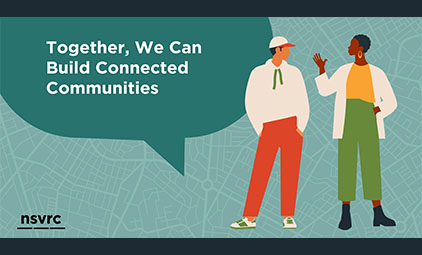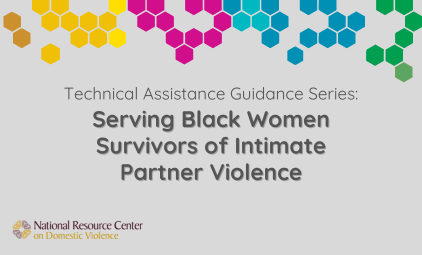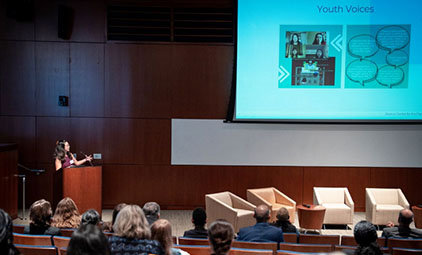This discussion guide offers questions to consider after reading the Applied Research paper titled The Effectiveness of Sexual Assault Services in Multiservice Agencies, by Debra Patterson with contributions from Sally Laskey (September, 2009). After reading the paper, discuss key topics and brainstorm next steps. These discussions may assist in cultivating services for people healing from sexual violence. Questions are listed by topic and additional resources to promote further learning are shown at the end.
Survivor-centered efforts:
According to Patterson’s paper, organizations that offer a variety of services can make pointed efforts to provide services for sexual violence survivors that are accessible and meaningful. Consider the following questions:
- What services do you think are most valuable in supporting the needs of a sexual violence survivor in the short term? In the long term?
- What does safety look or feel like for a person healing from sexual violence? How might this be different from a person who experienced intimate partner violence or other crimes?
- Are there populations, communities, or individuals who may not have access to services? Why is this? What can be done to change it?
- What can agencies do to provide both domestic violence crisis services/shelter and ongoing support for healing from sexual violence? Brainstorm some ideas and approaches.
- Why do you think it can be challenging for center staff to ask about or discuss experiences of sexual violence?
Brainstorm some of the ways that your organization can help to meet the unique needs of the following groups:
- Teen sexual violence survivors
- Adult survivors of child sexual abuse
- Communities of Color
- Children
- Rural communities
- Men and boys
- People who identify as LGBTQ
- Survivors of Intimate Partner Sexual Violence (IPSV)
- People with disabilities
- People who choose not to report to the police
- People who speak languages other than English
Are there others you can think of?
Movement building
Early efforts by grassroots activists in the feminist movement led to the creation of free-standing centers that provided counseling, support and advocacy for women who experienced sexual violence. Over time changes in funding, legislation, and in research on sexual violence affected the types of services offered and the make-up of the organizations that provided them. The research shows that sexual violence impacts people of all identities and that some groups of people are disproportionately affected (NISVS, 2011). Expanding, broadening, and rethinking sexual violence services are critical to movement sustainability. Patterson’s paper raised several issues related to the services provided by organizations in the anti-sexual violence movement. The following questions may help in thinking through some of the changes and directions ahead.
- Why do you think early anti-violence activists believed free-standing sexual violence services were valuable?
- How are social change and community mobilization related to violence prevention?
- Why should prevention through social change be a priority in your organization or community?
Organizational Capacity
Organizations face specific tasks and challenges related to keeping the organization running, setting priorities, and planning strategic efforts and initiatives. Thinking through some of the ways that your organization can assess personal capacity and make meeting the needs of sexual violence survivors a priority may be helpful in expanding services.
- What qualities or approaches can promote balanced organizational decision-making that supports the needs of all survivors?
- What role can a counselor play in bringing sexual violence-specific services and needs to the table in an organization?
- What role can a prevention educator play?
- An administrator or leader?
- A volunteer?
- A staff member from a state coalition?
- Survivors?
- How might funding influence the decision to combine services? What are the possible positive outcomes? Negative outcomes?
- How do funding concerns create tension within an anti-violence organization?
- How can multi-service agencies benefit people who have experienced multiple forms of victimization? Identify several topics for cross-training.
Personal Reflections
- How do your experiences relate to the information presented here?
- What can you take away from the article that will help you to rethink your services or response to sexual violence survivors?
Additional Resources
Marital Rape: This 30-minute course guides participants to learn the definition, risk factors, and effects of marital rape and will be able to identify potential intervention strategies.
Confronting the Sexual Abuse of Women with Disabilities: This paper covers unique factors and pointed advocacy efforts that may be helpful in serving survivors with disabilities.
Sexual Violence in the Lives of African American Women: Risk, Response, and Resilience: This paper addresses historical context, survivor traits, risk factors, health consequences, culturally sensitive responses, and resilience of survivors.
Screening for Sexual Violence: Gaps in Research and Recommendations for Change: This paper provides a review of research on screening women for sexual violence in health care facilities, and discusses the reasoning and rationale behind screening women for sexual violence.
Culturally Competent Service Provision to Lesbian, Gay, Bisexual and Transgender Survivors of Sexual Violence: This paper reviews research focusing on LGBT survivors of sexual trauma and offers recommendations for culturally competent service provision to LGBT clients.
Changing Perceptions of Sexual Violence Over Time: The author reviews available research on perceptions held by the general public about sexual violence and how they have changed over time. She also makes recommendations for future practice, which include discussing the root causes of sexual violence and addressing subtle victim blaming.
Men and Boys: Preventing Sexual and Intimate Partner Violence: This Special Collection provides resources for anti-violence programs to increase their capacity to engage men and boys in their work to end violence against women. The collection explores the social construction of masculinity and the impact that pro-feminist men can have on advancing the anti-violence movement.
Self-Care and Trauma Work: This document provides a brief overview of vicarious trauma and how to take care of yourself when working to address sexual violence.
Action, Engagement, Remembering: Services for Adult Survivors of Child Sexual Abuse: This paper explores the practices of rape crisis centers and coalitions as they act, engage, and remember with adult survivors of child sexual abuse with strategies in crisis intervention, counseling, holistic healing, and advocacy for adult survivors of child sexual abuse.












